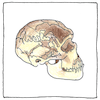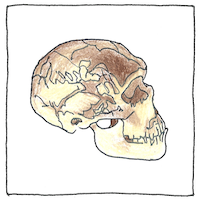Hermann Schaaffhausen
primatology

|
Neanderthal man
Lacking the concept of extinct human species, Hermann Schaaffhausen fit the evidence in the Feldhofer cave above the Neander Valley near Düsseldorf into the history he knew. Limestone quarrymen had blasted open the cave and told Hermann, the local schoolteacher, that they had found old bear bones. Recognizing that these were not bear bones, and knowing that the Romans had driven out less civilized tribes from the region, Hermann explained that these were the bones of a pre-Roman race, “barbarous and savage.”
Homo neanderthalensis
Seven years after Schaaffhausen announced the bones with their pronounced brow ridges found with bones of extinct mammals from before the last ice age, Professor William King in Galway first acknowledged that they represented an extinct and human cousin of our species which lived side-by-side in Europe with our ancestors for a hundred thousand years before they disappeared.
The disappearance
Everyone says we don’t know why the Neanderthals disappeared, but it should be obvious if one considers the rate at which humans have been destroying other cultures, other languages, other habitats, other tribes, races, and species. It should be obvious if one considers our recent histories of pogroms, holocausts, and genocides. In the darkness of every human persists a disappearing region touched by fear and hatred that is difficult to question and hard to own.



We know now that Neanderthals and Homo sapiens interbred, which means that they were not a different species from us; nevertheless, they keep a different species name, Homo neanderthalensis.
At the time, scientists were worried about how to reconcile them with our notions of superiority. No one wanted to claim them as human ancestors. Even though the bones were about 350,000 years old, no one wanted to admit that the fossils were ancient. Rudolf Virchow claimed that they were only bones of a modern man deformed by rickets, arthritis, and heavy blows to the head. When Marcellin Boule studied the nearly complete Neanderthal bones that were discovered starting in 1908 in the Dordogne, he misconstrued everything, ignoring the large cranial capacity and the fine hands. He arranged the big toes like an ape’s, the knees so they could not straighten, and the spines so they could not walk upright. Boule declared that the Neanderthal were mentally retarded and physically like apes.
I have resisted the idea that our own kind is special in the capabilities of our hearts or minds. Other animals also have hearts and minds and it is narrow-minded to assume that they do not use them in the same ways we use ours. Our record of intelligence is not matched by our ability to control and to manufacture; other animals have better histories of survival without killing others or destroying the environment that their survival depends on.
Cro-Magnon lived in the same Europe as the Neanderthals for about 10,000 years. The fact that the Neanderthals are gone today does not show that they were incapable of surviving. Cro-Magnons might have peacefully coexisted with Neanderthals, or competed with them for resources, or assimilated them, or murdered them.
See also in The book of science:
Readings in wikipedia: